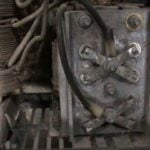Connection rear drum roller to allow their relative rotation; therefore, not as a leading (he’s not even wearing slab), rear drum serves as a locking cover that protects from the selection of the code to the touch during the rotation closest to the plate. The cord for aesthetics “hidden” in the case of cambrica suitable diameter.
The lock body is made of duralumin, and the rest turned parts made of steel 20.
For trela requires a specific sequence of manufacture, guaranteeing the clarity of the castle. First, you need on a lathe to process the end surface of the workpiece plate, then drill it in the centre
Central hole with a diameter of 6 to a depth of 6 mm and run a bore with a diameter of 22 to a depth of 2.8 mm. Further processing the outer cylindrical surface of the plate with a diameter of 26 mm, using the body as the caliber. The pairing should be such that case, the workpiece plate rotates freely but without radial play. Finally cut detail size of 4.8 mm.
Subsequent operations on the plate are performed in conjunction with the lock housing. The workpiece plate is inserted into it and is a design position. Using the body as a conductor, you need to drill in the plate hole with a diameter of 3 mm. Further, by rotating the plate relative to the housing at 30° and using it now as a jig, to drill in the housing parallel to its axis deaf technological hole with a diameter of 3 mm (not shown). Inserting a rod with a diameter of 3 mm, to fix the angular displacement of the plate by 30° and, again using the hull as a conductor, to drill the plate in the second hole with a diameter of 3 mm. Further, shifting the plate each time one step, drill eight holes, so you have 10.
The final stage is the countersinking of the holes in the plate to a depth of 0.5 mm. Here it is necessary to try that all holes were the same.
The plate is ready to be marked as front and rear Assembly lock set only on its position (custom fitting).
Remains counterbore file the center hole with a diameter of 6 mm each plate in a square of side 6 mm and a drawing hole diameter of 3 mm in the case be drilled to 4 mm.
To mark the cutouts in the sides tarala insert in the housing the balls with a diameter of 4 mm (fit bearing Bicycle pedals) and the spring. Next, by setting the plate and hold the whole Assembly between thumb and forefinger, to ensure that each ball was in one of the holes of your plate. The sequence number of the wells have code for this plate.
Through the hole in the housing with a diameter of 10 mm have a Scriber to mark on the sides tarala cutouts. To disassemble the node and vyfrezerovkami (or a file to saw through) cut-outs, increasing their radius by 0.5 mm.
Retaining rings made of steel wire with a diameter of 1.5—1.6 mm.
For a flexible “bow” lock length 800 mm suitable section of steel rope with a diameter of 3 mm (you can use one strand of thicker rope).
Before final mounting parts of the lock should be lubricated with a thin layer of grease for protection against corrosion.
The Assembly sequence can be as follows. Insert in the housing in its place the right tip and the tube tip — lock (to lock) and zaccanti it there in the core at three points.
Wear on the cable and the tube right to the tip sleeve of the required length to allow zaccanti to the other end of the rope in the left tip.
To assemble a ratchet, fixing the plate in the housing with fixing rings. Combining cutouts tarela with a hole of 10 mm diameter of the housing. Check out “stalemate” left tip into the slot of the housing; if not included, then disassemble, adjust the cut file and put it back together again.
When assembling the ratchet is better to lay a pinch of graphite powder, because a liquid or grease will affect the definition of ratchet in the cold (it will take some time to warm the castle).
Combination bike lock:
1 — housing; 2 — back plate; 3 — left (lockable) tip; 4 — throttle cable (d3, L800); 5 — roller; 6 — retaining ring (2); 7 — front plate; 8 — spring; 9 — ball (2 PCs); 10 — front drum; 11 rear drum; 12 — right (fixed) tip; 13 — the case of the cable (sleeve)
To screw on the front roller drum. Insert the roller into the housing and inserting it alternately into engagement with both teralani, test free are its square flanges into the holes in tarlach in the four possible positions of engagement. If you need to customized to free, without jamming, connections,.
Remove the cushion and finally screw on front drum to capacity (interference) be careful not to bend anything, flared threaded end.
Reinsert the platen into the housing (in design position), put back the drum to stop and the flared end of the cushion.
Now you can define a lock code, enter the front drum engaged with one of tarela and rotate it to pause in the clicks. Then continue to rotate the plate, counting the clicks to align the cutout in the Board that-reli-with a hole under the left tip in the housing. The number of clicks and will be a source of this plate in the direction of rotation. The same is done with another plate.
In order to close the lock, it is necessary to bring the plate to the open position, insert the left tip into the lock body until it stops and hold it in this position, a slight axial force while turning to enter the front roller into engagement with one of tarela. On joining engage, evidenced by the abrupt “disappearance” of the drum in the direction of the axial force on the thickness of the wall plate. Rotate the drum to pause in the clicks. To improve the secrecy turn to pause in the clicks and the second plate by the engagement with her front drum its axial displacement relative to the housing, but in the other direction. Then put the drum in the neutral position (no gear with teralani).
For unlocking the lock must be counted the clicks to install both the plate code, and bring the front roller to the neutral position.
I. YANKIN, Baykonur, Kazakhstan
Recommend to read
 A SIMPLE “UNIVERSAL”
A SIMPLE “UNIVERSAL”
"Almost five years are a reader and subscriber of the journal "modelist-Konstruktor". During this time, produced in any published developments in several homemade "for home, for family."... THE ADVENTURES OF “AMERICAN” IN RUSSIA
THE ADVENTURES OF “AMERICAN” IN RUSSIA
Passenger car GAZ-A. Many people know the famous saying of the Patriarch of the American car industry Henry Ford — "the Buyer is entitled to choose a car of any colour provided that its...


